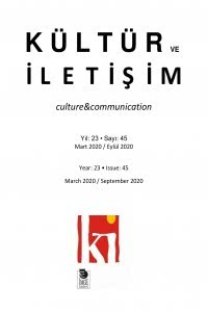Ulusaşırı Türk Topluluğunun Fatih Akın'ın Kısa ve Acısız'ında (Kurz und Schmerzlos) Gösterimi
Ulusaşırı Türk toplumu, Fatih Akın, sinema
Screening Transnational Turkish Community in Fatih Akın's Kurz und Schmerzlos (Short Sharp Shock)
___
"Archangel Gabriel." Catholic-pages.com. http:/ /www.catholicpages.com/ angels/ gabriel.aspAndelson, Leslie A. (2000). "Touching Tales of Turks, Germans and Jews: Cultural Alterity, Historical Narrative, and Literary Riddles for the 1990s." New German Critiqııe 80: 93-102.
Adelson, Leslie A. (2002). "The Turkish Tum in Contemporary German Literature and Memory Work." Gernıanic Review 77 (4): 326-338.
Bhabha, Homi (1994). "DissemiNation: time, narrative and the margins of the modern nation." Nation and Narration. Homi Bhabha (ed.). New York and London: Routledge. 291-323.
Bhabha, Homi (1994). Tlıe Location of Cııltııre. London: Rout!edge.
Buhre, Jakob (2002). "Ich könnte gar keine Filme machen, die keinen persönlichen Bezug zu mir haben." Interview mit Fatih Akın vom 16.10. 2002. www.planetinterview.de/ interviews / print.php?interview=akin-fatih.
Chapin, Wesley D. (1997). Gernıany far tlıe Gernıans? Tlıe Political Effects of International Migration. Westport, CT: Greenwood.
Ehrlacher, Frank (2003). "Kurz und Schmerzlos." web-site: Movie-Master. http: / / www.moviemaster.de/ index /htm ?archiv /film/ film. php ?nr=1241.
Fenner, Angelica (2000). "Turkish Cinema in the New Europe." Canıera Obscııra 15 (2): 105-148.
Göktürk, Deniz (2002a). "Beyond Paternalism: Turkish German Traffic in Cinema." Tlıe Gernıan Cinema Book. Tim Bergfelder, Erica Carter and Deniz Göktürk (eds.). London: BFI. 248-57.
Göktürk, Deniz (2002b). "Turkish delight - German fright. Migrant identities in transnational cinema." Tıırkis/ı cinema news/etter. http: / /www.turkfilm.net/ arc106.html
Hargreaves, A.G, (1997). Voices Jrom tlıe Nort/ı African Comnıunity in France: Imnıigration and Identity in Beıır Fiction. Oxford: Berg.
Hargreaves, A. G. (1989). "Beur Fiction: Voices from the Immigrant Community in France." Tlıe Frenclı Review 62: 661-68.
Horrocks, David and Kolinsky, Eva (eds.) (1996). Tıırkislı Cııltııre in Gernıaıı Society Today. Providence, RI: Berghahn Books.
Kuhn, Anna (1989). "Bourgeois Ideology and the (Mis)Reading of Ganz Unten." New Gernıan Critiqııe (Special Issue on Minorities in German Culture) 46: 191-203.
Leggewie, Claus and Şenocak, Zafer (eds.) (1993). Deııtsclıe Türken - Türk Almanlar. Reinbeck bei Hamburg: Rowohlt.
Mushaben, Joyce Marie (1998). Fronı Post-War ta Post-Wall Geııerati~ııs: Clıanging Attitııdes toward tlıe National Qııestion and tlıe Nato in tize Federal Repııblıc of Gemıany. Boulder, Co: Westview Press.
Naficy, Hamid (1993). "Exile Discourse and Televisual Fetishizati?n." ~tlıerııess aııd tlıe Media. Tlıe Etlınograplıy of tlıe Imagined and tlıe Imaged. Hamıd Nafıcy and Teshome H. Gabriel (eds.). Chur (Switzerland): Harwood Academic Publishers.
Naficy, Hamid (2001). An Acceııted Ciııenıa: Exilic and Diasporic Filmnıakiııg. Princeton, N.J: Princeton UP.
- ISSN: 1301-7241
- Yayın Aralığı: 2
- Başlangıç: 1998
- Yayıncı: İmge Kitabevi Yayınları
İnternet Zamanında Aile İlişkileri
Emine ONARAN İNCİRLİOĞLU, Barış KILIÇBAY
Hacker Etiği: İş Hayatına Yıkıcı Bir Yaklaşım
Modernleşmeyi Okumak: Ülkü Dergisi (1933-1938)
Bir Gazetenin Tarihi, Cumhuriyet Aysun Köktener (2004)
Malumat Dünyasına Gitmek ... Mektuplar: Erol Mutlu
Bizim Çocuklar ve Ötekiler: Haber Medyasında Çocukların Resimleri
Yurt Dışındaki Türk Medyası Sempozyumu
Ulusaşırı Türk Topluluğunun Fatih Akın'ın Kısa ve Acısız'ında (Kurz und Schmerzlos) Gösterimi
Ulusaşırı Türk Topluluğunun Fatih Akın'ın Kısa ve Acısız'ında (Kurz und Schmerzlos) Gösterimi
